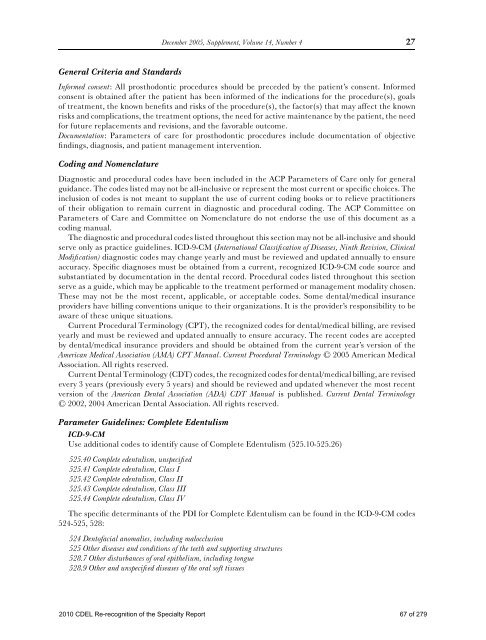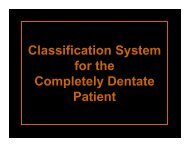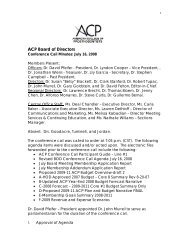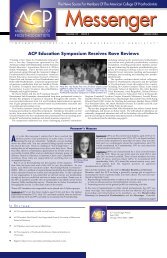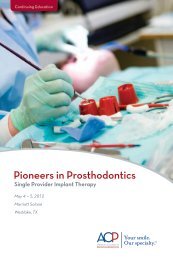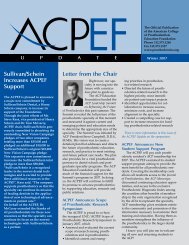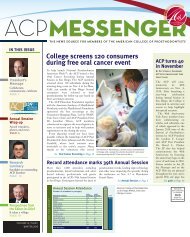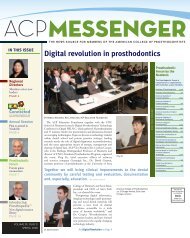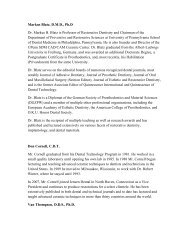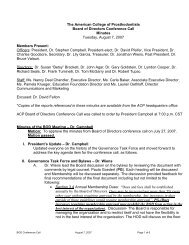PROSTHODONTICS - American College of Prosthodontists
PROSTHODONTICS - American College of Prosthodontists
PROSTHODONTICS - American College of Prosthodontists
You also want an ePaper? Increase the reach of your titles
YUMPU automatically turns print PDFs into web optimized ePapers that Google loves.
December 2005, Supplement, Volume 14, Number 4 27General Criteria and StandardsInformed consent: All prosthodontic procedures should be preceded by the patient’s consent. Informedconsent is obtained after the patient has been informed <strong>of</strong> the indications for the procedure(s), goals<strong>of</strong> treatment, the known benefits and risks <strong>of</strong> the procedure(s), the factor(s) that may affect the knownrisks and complications, the treatment options, the need for active maintenance by the patient, the needfor future replacements and revisions, and the favorable outcome.Documentation: Parameters <strong>of</strong> care for prosthodontic procedures include documentation <strong>of</strong> objectivefindings, diagnosis, and patient management intervention.Coding and NomenclatureDiagnostic and procedural codes have been included in the ACP Parameters <strong>of</strong> Care only for generalguidance. The codes listed may not be all-inclusive or represent the most current or specific choices. Theinclusion <strong>of</strong> codes is not meant to supplant the use <strong>of</strong> current coding books or to relieve practitioners<strong>of</strong> their obligation to remain current in diagnostic and procedural coding. The ACP Committee onParameters <strong>of</strong> Care and Committee on Nomenclature do not endorse the use <strong>of</strong> this document as acoding manual.The diagnostic and procedural codes listed throughout this section may not be all-inclusive and shouldserve only as practice guidelines. ICD-9-CM (International Classification <strong>of</strong> Diseases, Ninth Revision, ClinicalModification) diagnostic codes may change yearly and must be reviewed and updated annually to ensureaccuracy. Specific diagnoses must be obtained from a current, recognized ICD-9-CM code source andsubstantiated by documentation in the dental record. Procedural codes listed throughout this sectionserve as a guide, which may be applicable to the treatment performed or management modality chosen.These may not be the most recent, applicable, or acceptable codes. Some dental/medical insuranceproviders have billing conventions unique to their organizations. It is the provider’s responsibility to beaware <strong>of</strong> these unique situations.Current Procedural Terminology (CPT), the recognized codes for dental/medical billing, are revisedyearly and must be reviewed and updated annually to ensure accuracy. The recent codes are acceptedby dental/medical insurance providers and should be obtained from the current year’s version <strong>of</strong> the<strong>American</strong> Medical Association (AMA) CPT Manual. Current Procedural Terminology C○ 2005 <strong>American</strong> MedicalAssociation. All rights reserved.Current Dental Terminology (CDT) codes, the recognized codes for dental/medical billing, are revisedevery 3 years (previously every 5 years) and should be reviewed and updated whenever the most recentversion <strong>of</strong> the <strong>American</strong> Dental Association (ADA) CDT Manual is published. Current Dental TerminologyC○ 2002, 2004 <strong>American</strong> Dental Association. All rights reserved.Parameter Guidelines: Complete EdentulismICD-9-CMUse additional codes to identify cause <strong>of</strong> Complete Edentulism (525.10-525.26)525.40 Complete edentulism, unspecified525.41 Complete edentulism, Class I525.42 Complete edentulism, Class II525.43 Complete edentulism, Class III525.44 Complete edentulism, Class IVThe specific determinants <strong>of</strong> the PDI for Complete Edentulism can be found in the ICD-9-CM codes524-525, 528:524 Dent<strong>of</strong>acial anomalies, including malocclusion525 Other diseases and conditions <strong>of</strong> the teeth and supporting structures528.7 Other disturbances <strong>of</strong> oral epithelium, including tongue528.9 Other and unspecified diseases <strong>of</strong> the oral s<strong>of</strong>t tissues2010 CDEL Re-recognition <strong>of</strong> the Specialty Report 67 <strong>of</strong> 279


